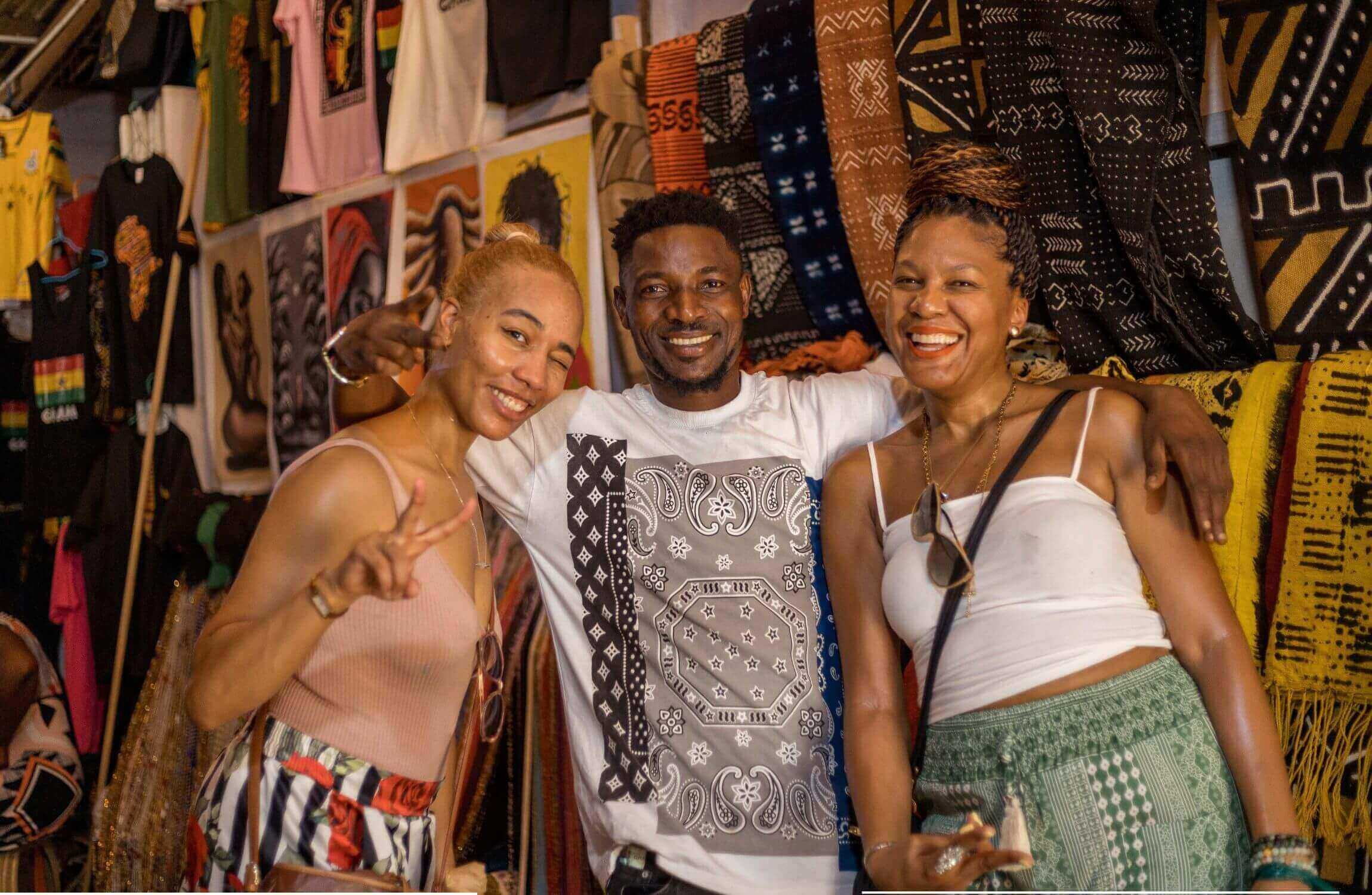What to Wear in Ghana: A Complete Guide for Travelers
As you prepare for your Ghanaian adventure, one crucial aspect to consider is how to dress appropriately. Your clothing choices can significantly impact your comfort, cultural sensitivity, and overall experience. In this blog, we'll explore how to dress for Ghana's seasons and various tour sites, ensuring you're well-prepared for every aspect of your journey.
Understanding Ghana’s Climate
Before we dive into specific clothing recommendations, it's essential to understand Ghana's climate. Ghana has a tropical climate with two main seasons: dry (November to March) and wet (April to October). The weather is generally warm and humid throughout the year, with temperatures ranging from 21°C to 35°C (70°F to 95°F). However, the climate varies slightly between the southern coastal areas, the forest regions, and the northern savannah.
How to Dress for the Various Seasons
Dry Season (November to March)
Characterized by hot, dry weather
Temperatures ranging from 21°C to 35°C (70°F to 95°F)
Low humidity and little to no rainfall
Rainy Season (April to October)
Warmer temperatures with increased humidity
Regular rainfall, especially from June to August
Temperatures ranging from 22°C to 30°C (72°F to 86°F)
How to Dress during the Rainy Season
Lightweight, Quick-Drying Clothing
During the rainy season, opt for lightweight, breathable fabrics like cotton or linen that dry quickly. Consider wearing moisture-wicking clothes that can handle the humidity and occasional rain showers. I personally like to avoid heavy fabrics that can become uncomfortable when wet.
Tops & Bottoms
Wear lightweight, water-resistant jackets or raincoats especially during periods when the country experiences a lot of unexpected rains. Pack some breathable, quick-dry shirts or blouses and quick-drying trousers or skirts.
Footwear
Waterproof shoes or sandals are ideal. Consider shoes with good grip, as the roads and paths can become slippery when wet. Avoid leather shoes that might get damaged by the rain.
Accessories
If you visit during the rainy season, always remember to carry a compact umbrella and a waterproof bag to protect your belongings from unexpected downpours. Bring an extra pair of shoes when you are packing in case one gets wet.
How to Dress during the Dry Season
Breathable Fabrics
The dry season is hot, so choose loose-fitting, light-colored clothing made from breathable fabrics like cotton, linen, and lightweight rayon. These materials will help keep you cool in the heat. Avoid synthetic fabrics that can trap heat and moisture.
Tops & Bottoms
Wear loose-fitting, short-sleeved shirts or blouses or light, long-sleeved shirts for sun protection on days with higher temperatures. When I am going for a casual look, I usually opt for cotton t-shirts. You can also wear lightweight, loose-fitting trousers, long skirts, or knee-length shorts.
Dresses
This time of the year is also a good time to wear loose, flowing sundresses. But I will mostly wear this during the day as it can get a bit chilly early morning and in the evening around this time of the year.
Layering
In the northern regions during the harmattan, temperatures can drop significantly in the evenings and early mornings. Bring a light sweater or jacket for layering, especially if you're visiting in December or January.
Footwear
Comfortable breathable walking shoes or sandals are a must. If you plan to hike or explore rugged areas, opt for sturdy shoes with good ankle support. Avoid high heels, especially on unpaved roads. I personally prefer to wear high heels when I know I am mostly going to be indoors as most streets in Ghana have no pavements for pedestrians which can make it difficult to walk outside in high heels.
Accessories
The sun can be intense during the dry season and sometimes during the middle of the year, so wear a wide-brimmed hat, sunglasses, and sunscreen. On such days, you can also wear long-sleeved shirts and pants that can also protect your skin from sunburn.
How to Dress for Specific Tour Sites and Locations
Different tour sites and locations in Ghana may require varying degrees of formality or modesty in dressing. Here are some recommended outfits for some popular destinations and locations.
1. Cities and Towns (Accra, Kumasi, Cape Coast):
Casual and Comfortable: Ghanaian cities are generally relaxed, but it's important to dress modestly, especially in public places. Women might opt for dresses, skirts, or trousers with blouses or t-shirts. Men can wear shorts or trousers with casual shirts or polo shirts. When visiting markets wear a crossbody bag or secure backpack for valuables
Respectful Dressing: While the dress code is not overly strict, showing too much skin can be frowned upon, especially in religious or traditional areas. Avoid extremely short shorts, mini skirts, or revealing tops. Modest clothing helps you to blend in with locals.
Evening Outfits: If you're planning to visit restaurants, bars, or nightclubs, you can dress up a bit more. A nice dress or a smart casual outfit will be appropriate for most venues.
2. Beaches (Kokrobite, Busua, Ada Foah, etc)
Beachwear: Ghana’s beaches are laid-back, and swimwear is acceptable on the beach. However, when leaving the beach area, it's courteous to cover up with a wrap, dress, or shirt. When visiting the beach, I like to have a sun hat and sunglasses which offer some shade from the sun.
Light Clothing: Since beach areas are often hot and sunny, wearing light and airy clothing. Sarongs, kaftans, and beach dresses are great options for women, while men might prefer light shorts and t-shirts.
Footwear: Flip-flops or sandals are perfect for the beach, but if you plan to explore rocky shores, consider water shoes for better protection.
3. Historical Sites (Elmina Castle, Cape Coast Castle, Manhyia Palace)
Modest and Respectful: When visiting historical sites, especially those with significant cultural or religious importance, modest dressing is appreciated. Women should consider wearing skirts or trousers that cover the thighs and tops that cover the chest area. Men can wear trousers or longer shorts with a shirt.
Comfortable Footwear: These sites often involve a lot of walking and sometimes climbing stairs, so wear comfortable shoes. Avoid high heels or other uncomfortable shoes not appropriate for walking tours.
4. National Parks and Wildlife Reserves (Mole National Park, Kakum National Park)
Neutral Colors: When visiting wildlife reserves, it's best to wear neutral-colored clothing like khaki, brown, or green. Bright colors can startle animals and make you more noticeable to insects.
Long Sleeves and Pants: To protect yourself from insect bites, especially mosquitoes and scratches, wear long-sleeved shirts and long pants. Lightweight, breathable fabrics are best to keep you cool while covered.
Sturdy Footwear: Closed-toe shoes or hiking boots are essential for exploring the parks. Ensure your shoes are comfortable for long walks and provide good support.
Accessories: A wide-brimmed hat, sunglasses, and a backpack for water and snacks are advisable. Consider bringing binoculars and a camera to capture the wildlife.
5. Cultural Festivals and Events (Chale Wote Street Art Festival, Akwasidae, Homowo)
Traditional Attire: If you’re attending a cultural festival or event, wearing traditional Ghanaian attire, such as a kente or batakari, can enhance your experience and show respect for the local culture. Many visitors choose to purchase these beautiful garments as souvenirs.
Bright and Festive: Festivals are vibrant and colorful, so feel free to dress in bright, cheerful colors. However, ensure your outfit is comfortable, as festivals often involve dancing, walking, and standing for extended periods.
Footwear: Comfortable sandals or shoes are recommended, as you may be on your feet for much of the day.
6. Religious Sites (e.g., National Mosque, churches)
Conservative, modest clothing
Women: long skirts or trousers, covered shoulders
Men: long trousers, collared shirts
Remove shoes when entering mosques
7. Traditional Villages and Rural Areas
Modest, respectful clothing
Avoid overly revealing or flashy attire
Comfortable, sturdy shoes for uneven terrain
8. Upscale Restaurants or Events
Smart-casual to semi-formal attire
Collared shirts and trousers for men
Dresses or smart separates for women
General Tips for Dressing in Ghana
While the dress code is not overly strict, showing too much skin can be frowned upon, especially in religious or traditional areas. Avoid extremely short shorts, mini skirts, or revealing tops.
If you plan to visit churches, mosques, or other religious sites, dress modestly, covering your shoulders, knees, and, for women, your hair if required. A scarf or shawl can be useful for this purpose.
Ghana is known for its beautiful textiles, including kente cloth, batik, and tie-dye. Purchasing clothing made from these fabrics not only supports local artisans but also allows you to immerse yourself in the culture. Tailors and seamstresses in Ghana can create custom outfits if you wish to have something unique.
Avoid anything too flashy or attention-grabbing like expensive jewelry.
Prioritize comfort over style, especially when exploring cities or natural areas.
Always bring a hat, sunglasses, and high-SPF sunscreen as you will need it for protection against the sun.
Ghanaian weather can be unpredictable, especially during the rainy season. Dressing in layers and carrying versatile items, like a shawl or light jacket, allows you to adapt to changing conditions.
Consider buying some local clothing items for a more authentic experience and to support the local economy.
In rural or forested areas, long sleeves and trousers can help protect against insect bites especially at night.
Conclusion
Dressing appropriately for during your time in Ghana involves balancing comfort, cultural sensitivity, and practicality. By considering the season, your planned activities, and local customs, you can ensure that your clothing choices enhance rather than hinder your experience. Remember, while it's important to dress respectfully, Ghanaians are generally warm and welcoming people who appreciate visitors making an effort to embrace their culture. With this guide in hand, you're well-prepared to dress comfortably and appropriately as you explore the wonders of Ghana. Enjoy your trip!
Don’t forget to share your thoughts and expectations in the comment section for your visit to Ghana!
Related
How to Explore Ghana on a Budget- Everything You Need to Know
25 Local Customs and Etiquette you should know when traveling to Ghana
Download my free travel guide to navigating Accra- Ghana from hotels to stay at, restaurants to try out, how to stay safe when visiting and nightlife recommendations for my fellow night owls who would love to go dancing.
Hello, fellow adventurers! I'm Rashida, your not-so-typical travel guide. Join me for laughs, mishaps, and perhaps a questionable decision or two (because let's face it, those always make for the best stories). Learn More







